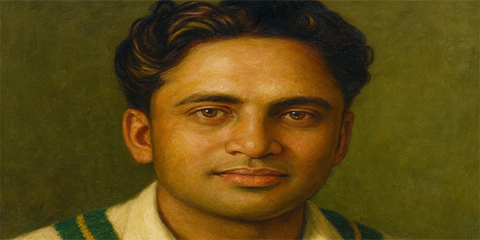Joe Root: The art and artisan of modern cricket
JournalismPakistan.com | Published last year | Dr. Nauman Niaz (TI)
Join our WhatsApp channel
From the times of Alfred Shaw’s underarm daisy-cutters to the age of the Dukes ball’s fickle seam, English cricket has witnessed a cluster of batsmen, each sculpting their legacy as achievers. Yet, amidst this illustrious procession of greats, one name now surfaces with undeniable clarity, Joseph Edward Root. In Root, we find not only a batter of supreme talent but a player whose genius and spirit outdo the epochs of cricket, challenging the supremacy of every English batter since the genesis of Test cricket in 1876-77.
The Measure of Greatness: Beyond Mere Numbers
Greatness in cricket is often tethered to the tyranny of numbers, aggregate runs, averages, and centuries scored. Root’s statistical dossier is awe-inspiring, a gleaming array of achievements that would place him comfortably among the elite of any generation. Over 12,000 Test runs and a century tally of 36, the last 19 arriving in only three years since 2021, best mark him as a colossus of modern batsmanship. Yet, to marginalize Root to just statistics would be to trivialize the essence of his genius.
His greatness lies in the intangibles: the poise with which he navigates pressure, the elegance of his strokeplay, and the indefatigable spirit that animates his craft. Root does not only score runs; he authors innings of narrative beauty, infused with a sense of purpose that speaks to the soul of cricket. It is here, in the realm of artistry and temperament, that his claim to being the greatest English batter ever finds its most persuasive voice.
The Lineage of English Greats: Root Amongst Titans
To anoint Root as England’s finest is to invite comparisons with a constellation of past geniuses whose legacies are part of the folklore. There was Arthur Shrewsbury, A.E. Stoddart, W.G. Grace, the progenitor of the modern game, bestrides the 19th century like a colossus, his feats as much myth as reality. Yet, Grace’s era was one of nascence, where technique and fitness often played second fiddle to bravado.
Root, by contrast, operates in a receptacle of relentless scrutiny, where every chink in the armour is revealed by technology and analysis.The interwar years brought forth Jack Hobbs and Herbert Sutcliffe, men whose stoic brilliance epitomized English batsmanship. Hobbs, the ‘Master,’ paired artistry with adaptability, yet his career, divided by the Great War, spanned two distinct periods. Sutcliffe, Root’s fellow Yorkshireman, was a quintessence of reliability in adversity, his performances steeped in the ethos of triumph against all odds.
Root’s consistency in a far more demanding milieu, however, elevates his stature beyond even these immortals. Post-war England gave rise to the prodigious talents of Len Hutton, Peter May, and later, Ken Barrington. Hutton’s meticulous technique, forged in the fires of Yorkshire cricket, made him the bedrock of England’s batting. Yet, Hutton’s career, while glittering, unwrapped in a time when the demands of international cricket were less exacting than they are today. Root, shouldering the burdens of a batting order often prone to fragility, operates in times of relentless tours and highly competitive formats, something Hutton never endured.
The modern age brought Ian Botham’s audacity, David Gower’s languid elegance, and Kevin Pietersen’s audacious brilliance. Yet, for all their virtues, these players lacked Root’s monastic consistency. Where Botham and Pietersen dazzled in bursts, Root endures, a source of reliability whose genius is as steady as it is spectacular.
Root and the Philosophy of Modern Batsmanship
Root’s greatness is also a philosophical statement, an incarnation of the evolution of batsmanship itself. Where the greats of yesteryears relied on their brilliance, be it Hobbs’s precision or Gower’s artistry, Root integrates the old and the new with seamless poise. His technique, grounded in the classical principles of balance and timing, adapts effortlessly to the demands of modernity, whether countering the prodigious turn of a subcontinental wicket or neutralising the vituperation and virulence of a new pink ball under lights.
Root’s method is an exploration of cricket’s eternal tension between the cerebral and the visceral. He is a craftsman who shapes his innings with the meticulous care of an artist refining a masterpiece. Yet, there is also a warrior’s pragmatism in his cricket, a refusal to be subdued, even when confronted by the world’s finest bowlers. It is this duality, artistry tempered by steel, that places him above his peers and many of his predecessors. His static and dynamic balance backed by an impenetrable technique and the ability to innovate brings runs and consistency.
Legacy and the Question of Eternity
To declare Joe Root as the finest English batter ever is not only to crown him king of an illustrious lineage but to acknowledge a new standard for batsmanship itself. Root’s legacy is not confined to the runs he has scored or the records he has broken; it resides in the ethos he represents, a commitment to the beauty, endurance, and adaptability of cricket.
In Root, the dichotomies of English batsmanship, art and grit, flair and discipline, tradition and modernity, find their apotheosis. He is, at once, a reflection of cricket’s heritage and its most eloquent exponent in the present. As he strides to the crease, his bat aloft in understated defiance, we see not just a batter but a living evidence of cricket’s timeless appeal, a man who belongs not only to his era but to eternity, above all others, a name that resonates with the congruence of skill, originality, and withstanding greatness: Joseph Edward Root.
Joe Root and the Pantheon of English Batsmanship: A Philosophical Exploration
English cricket’s rich arras are entwined with greatness, batsmen who have left their legacies behind through their methods, runs, technique, and excellence. To juxtapose Joe Root against the greats of the past is to draw comparisons and initiate a philosophical meditation on the evolution of batsmanship. From W.G. Grace’s pioneering dominance to Alastair Cook’s relentless accumulation, these spectacular players occupy a distinct place in cricket’s ever-unfolding narrative. Root, however, emerges as the culmination of this lineage, a batsman who integrates tradition and innovation into an unparalleled opus of excellence and impact.
The Pioneering Architect: W.G. Grace
W.G. Grace, the patriarch of modern cricket, was less a batsman and more a force of nature. His towering presence at the crease, both physical and psychological, redefined the art of run-scoring. Grace’s method was a blend of brute strength and unerring precision, and his dominance was as much about his aura as his bat. Yet, his technique, by today’s standards, would seem rudimentary, a reflection of cricket’s wavering beginnings.
In Root, one perceives a philosophical antithesis to Grace. Where Grace commanded through imposition, Root conquers through subtlety. Grace’s batting was a statement of superiority; Root’s is an expression of craft, fluid and adaptability. In going beyond the brute force of Grace’s era, Root exemplifies the refinement of cricket’s art form.
The Aesthetic Strategist: Archie MacLaren
Archie MacLaren, an aesthete with a flair for the dramatic, brought a cerebral dimension to English batting. His technique, though elegant, was often more theoretical than effective, and his inconsistency marked him as a flawed genius. Root, by contrast, marries MacLaren’s intellectual engagement with an unerring execution.
While MacLaren’s innings were fleeting works of art, Root’s body of work stands as a gallery of enduring masterpieces. His ability to adapt to conditions and opponents with the precision of a chess grandmaster ensures that his aesthetic brilliance is matched by uncompromising substance, a fusion MacLaren could only aspire to.
The Craftsman and the Engineer: Jack Hobbs and Herbert Sutcliffe
The partnership of Jack Hobbs and Herbert Sutcliffe represents the golden age of English batsmanship. Hobbs, the ‘Master,’ was a craftsman, blending artistry with economy of movement, while Sutcliffe’s engineering precision epitomised reliability. Together, they symbolised batsmanship as a harmonious balance of style and substance.
Root’s batting, while evoking the classical elegance of Hobbs, also carries Sutcliffe’s utilitarian spirit. His technique, grounded in textbook orthodoxy, is elevated by a contemporary adaptability that neither Hobbs nor Sutcliffe faced in their more homogenous cricketing world. Against relentless pace, mystery spin, and the unremitting scrutiny of modern technology, Root demonstrates a completeness that bridges the divide between Hobbs’ mastery and Sutcliffe’s pragmatism.
The Perfectionist: Len Hutton
Len Hutton was the archetype of technical perfection, a man whose batting was a study in precision. Hutton’s career, however, spread-out in an era constrained by post-war austerity, his genius often suppressed by circumstance.
Root, inheriting Hutton’s Yorkshire grit, extends his legacy into a realm of freedom and innovation. Where Hutton’s batting was often reactive, shaped by the exigencies of his time, Root’s is expansive and assertive, reflecting the possibilities of a more liberated era. Yet, the philosophical kinship between them is unmistakable, a shared dedication to the highest ideals of technique and run-getting excellence.
The Elegant Commander: Peter May
Peter May, with his languid elegance and unflappable demeanor, was England’s batting talisman in the 1950s. His ability to lead through example and anchor innings with all his elegance earned him a place among the greats. Root, as a leader and batsman, mirrors May’s calm assurance but surpasses him in versatility. Where May’s technique occasionally faltered against extreme pace, Root thrives across conditions and formats, blending May’s aesthetics with modern adaptability that makes him a far more complete batsman.
The Pragmatist: Ken Barrington
Ken Barrington, the epithet of pragmatism, though not pleasing to watch, an unorthodox tardy appearance, was a batsman who valued substance over style. His stubborn determination and penchant for marathon innings made him a pillar of England’s middle order.
Root, while sharing Barrington’s resolve, brings an added layer of fluency and elegance to his craft. Root’s ability to shift gears, to transform a stoic defence into an aggressive assault, distinguishes him from Barrington’s mundane approach. He is a pragmatist with an artist’s soul, blending the virtues of caution and creativity.
The Stoic and the Artist: Geoff Boycott and David Gower
Geoff Boycott and David Gower represent two polarities of English batsmanship. Boycott, the stoic accumulator, was relentless in his pursuit of runs, while Gower, the languid artist, batted with a nonchalant grace that belied his genius. Root reconciles these dualities with remarkable ease. He combines Boycott’s unblemished focus with Gower’s effortless elegance, creating a style that is as effective as it is beautiful. Root’s innings, while never reckless, carry an aesthetic charm that places him closer to Gower, yet his consistency evokes Boycott’s unsparing drive.
The Relentless Accumulator: Alastair Cook
Alastair Cook, England’s all-time leading run-scorer, now Root has left him behind was a model of endurance and discipline. His method, while unremarkable in its aesthetic, was brutally effective. Root, building on Cook’s template of consistency, adds a layer of artistry that makes his batting more universally admired. Where Cook often grounds bowlers into submission, Root dissects them with precision, his adaptability across formats and conditions elevating him to a higher plane of excellence.
Root: The Apex of Evolution
Joe Root is not only a product of his predecessors but their apotheosis. In him, we find the artistry of Hobbs, the resilience of Sutcliffe, the technical perfection of Hutton, the elegance of May, and the pragmatism of Barrington. He represents the stoicism of Boycott, the artistry of Gower, and the inexorable accumulation of Cook. Root’s genius lies in his ability to synthesise these qualities, creating a batsmanship that is both timeless and uniquely modern.
Root’s impact extends beyond the runs he scores; it resides in the philosophy he represents, a batsman who bridges the chasm between tradition and innovation, art and pragmatism, individuality and team ethos. He is not only England’s finest batter of the modern age but a cricketer whose greatness reverberates across the epochs, standing shoulder to shoulder with the immortals of English cricket.
The Genesis of Joe Root: A Symphony of Technique, Method, and Consistency in the Art of Batsmanship
In the history of cricket, few have embellished cricket with the poise and precision that define Joseph Edward Root. The genesis of Root as a batsman, while steeped in the rich traditions of Yorkshire cricket, overrides parochial borders, drawing a universal narrative of mastery, resilience, and evolution. His stroll from prodigy to maestro is an evidence not only to technical brilliance but to an intense understanding of the philosophy of batsmanship, an art form he elevates with every inning, rendering it timeless and transcendent.
Technique: The Anatomy of Elegance
Root’s technique is an architectural marvel, a balance of classical purity and modern adaptability. It is neither overwrought with ostentation nor bereft of individuality. His stance, compact yet fluid, mirrors the quiet poise of a monk before meditation, poised to respond to the vagaries of the bowler’s art. The bat in his hands becomes an extension of his intent, moving with a lyrical cadence that speaks of discipline forged in hours of toil.
Yet, Root’s technique is more than a sequence of movements; it is an exercise in anticipation. How he adjusts to the line and length of the ball, the soft hands guiding the ball into the gaps, and the deft footwork, all are reflections of a mind perpetually engaged in dialogue with cricket. It is as if Root, bat in hand, orchestrates a masterpiece, where every stroke finds its rightful place in the overarching melody.
Method: The Science of Execution
If technique is the foundation, method is the blueprint upon which Root constructs his innings. His approach to batting is deeply cerebral, underpinned by an acute awareness of cricket’s shifting dynamics. Root’s method is neither static nor rigid; it breathes and evolves with the rhythm of the match, oscillating between attack and defence with a fluidity that confounds opposition bowlers.
His ability to manipulate the field, to nudge and nurdle with precision, betrays a craftsman’s attention to detail. Yet, there is nothing mechanical about his method; it is impregnated with an intuitive brilliance, an understanding of the unspoken language of cricket. Root’s innings are not mere aggregates of runs; they are narratives, each ball a word, each over a sentence, building towards a crescendo that is as much about aesthetic beauty as statistical significance.
Execution: The Art of Repetition
Consistency is often perceived as the enemy of artistry, a mundane adherence to routine. Yet, in Root’s case, consistency becomes an art form, a manifestation of an unwavering commitment to excellence. His execution is characterized by an almost meditative repetition, where each stroke is an iteration of the ideal, refined through countless hours in the nets and in the middle of competition.
Root’s ability to convert starts into substantial scores is a hallmark of his genius. It is here that the philosophical underpinnings of his craft come to the fore, a recognition that greatness is not only the result of fleeting brilliance but of sustained endeavor. Each century, each partnership, becomes a brushstroke in the canvas of his career, contributing to a masterpiece that is as enduring as it is exquisite.
Impact and Role: The Atlas of English Cricket
Root's role is foundational and aspirational in the history of English cricket. As a batsman, he is the fulcrum around which the team pivots, his presence at the crease a bulwark against collapse and a source of hope. Yet, his impact excels the numerical; it is deeply symbolic, expressing the virtues of resilience, adaptability, and leadership.
Root’s tenure as captain added a layer of complexity to his role. While the burden of leadership occasionally dulled his performance, it also revealed his character, a dogged commitment to his team and the game. In relinquishing the captaincy, Root rediscovered the unfettered joy of batting, a liberation that reinvigorated his artistry and reaffirmed his place as one of the modern greats.
The Art of Batsmanship: A Philosophical Meditation
At its heart, Joe Root’s batsmanship is a meditation on the ephemeral and the eternal. It is a reminder that the essence of cricket lies not in the brute accumulation of runs but in the manner of their making. Root’s artistry evokes the timeless ethos of the game, a blend of poise and grit, of innovation and tradition, of individuality and team spirit.
His career is an allegory of human endeavor, a celebration of the virtues of perseverance and adaptability. In Root, we find a cricketer who outdoes the mundane metrics of averages and aggregates, symbolizing instead the timeless ideals of batsmanship, a craft that, in his hands, becomes an art form, a philosophy, a way of being.
And so, as Root strides to the crease, bat aloft, we are reminded that cricket, in its highest expression, is not only a battle but a canvas. In this space, the sublime and the earthly converge, where the artistry of a Joe Root paints visions that linger far beyond the boundary.
Dr. Nauman Niaz is a civil award winner (Tamagha-i-Imtiaz) in Sports Broadcasting and Journalism and a regular cricket correspondent, covering 54 tours and three ICC World Cups. He has written over 3,500 articles, authored 14 books, and is the official historian of Pakistan cricket (Fluctuating Fortunes IV Volumes—2005). His signature show, Game On Hai, has received the highest ratings and acclaim.

























